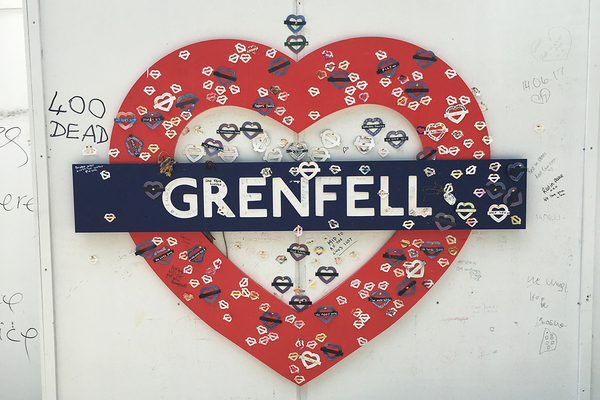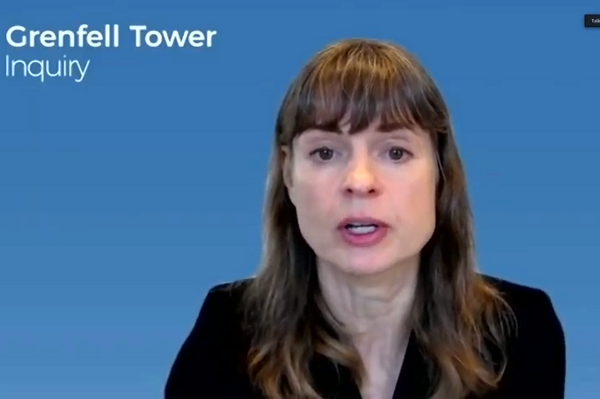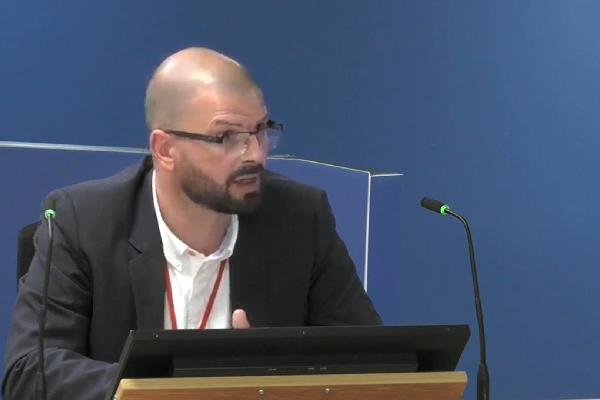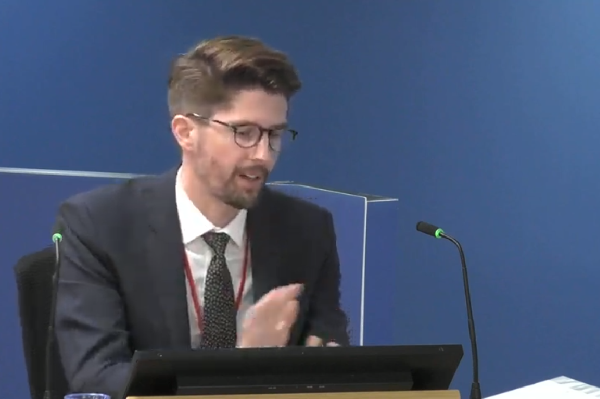Grenfell smoke dampers sold with ‘misleading’ testing information, inquiry hears
Devices designed to close the vents in the smoke control system at Grenfell Tower were sold with a “misleading” assurance that they had been successfully tested to prevent smoke leakage, the inquiry into the fire heard today.
The Grenfell Tower Inquiry has been investigating the design and refurbishment of the smoke control system in the tower over the past week.
It has already heard that the system was a bespoke design that was not compliant with relevant regulations and utilised ‘dampers’ of “the lowest possible standard”.
Dampers are devices fitted to the front of the vents which open during a fire to allow smoke in when activated but should remain closed on unaffected floors. Their failure means the system would be circulating smoke around the building during the fire instead of clearing it.
Today, Roy Jones, technical director at Gilberts Limited, the firm which sold the dampers, was grilled on the testing and marketing of the products.
He was asked about an October 2011 test on the product, where it failed to meet ‘smoke leakage’ criteria during both the fire test and in ‘ambient’ conditions.
However, a brochure for the product said the dampers had “undergone an [official test] for both fire integrity and smoke leakage but has no formal classification”. It did not clarify that the product had, in fact, failed to meet this criteria.
Mr Jones explained that the product was intended for use as a ‘fire damper’ not a ‘smoke damper’ and therefore was not required to meet the standards for smoke leakage.
He said the reference in the brochure was simply intended to explain what tests had been carried out and not to suggest the product had passed or failed.
The same sentence was included in formal quotes given to PSB UK, the contractor which worked on the refurbishment of the system in the tower and purchased the dampers.
“In light of your evidence and what we see on the page about the test, it’s not right, is it, that it [the damper] lasted for 60 minutes in terms of smoke leakage, is it?” asked counsel to the inquiry Alex Ustych.
“Yes, that’s an error,” said Mr Jones.
“And can you explain how this incorrect information came to be provided in both quotations sent in this case?” asked Mr Ustych.
“I assumed the quotation was a copy and paste from the brochure,” Mr Jones replied.
“Do you accept that could have a misleading effect on either the purchaser, or for example building control, who might be reviewing those additional nodes as part of their assessment,” asked Mr Ustych.
Mr Jones accepted this, but added that the product was compliant with guidance produced by the Smoke Control Association for dampers of this type.
“Given that the Series 54 damper [the product used in the Grenfell Tower’s system] failed the smoke leakage requirement, can you explain in what kind of scenario you anticipated being used in a smoke control system?” asked Mr Ustych.
Mr Jones said its purpose was for an “evacuation” system, where dampers would open on the fire floor and remain closed on all others. He said leakage on other floors would be limited by negative air pressure inside the ventilation shaft.
Witness statements of residents given in the first phase of the inquiry reported smoke leaking out of vents on the sixth, 20th and 23rd floors from as early as 20 minutes into the fire.
Following Mr Jones, the inquiry heard from Matt Cross Smith, an engineer at Max Fordham, the consultancy which was initially charged with the work to improve Grenfell Tower’s smoke system.
The consultancy was first asked to do this in 2012, following inspections which had shown the existing system in the building to be “beyond economic repair”.
Mr Cross Smith explained – in line with a previous witness – that designing a compliant system was challenging because the tower had been built with shafts that were narrower than the minimum requirements of guidance.
He said that “on the face of it” this meant the building was not compliant at the time of its construction in 1974, but when he tried to verify this “we found that [the Royal Borough of Kensington and Chelsea] had destroyed all records prior to 1990”.
The inquiry saw an analysis Mr Cross Smith produced in May 2013 which assessed the expected performance of the planned upgrade to the system, claiming it would improve the air flow by five times to five cubic metres per second.
He said this had been necessary because the council’s building control department had raised concerns that the team was not “adequately proving that your proposal is an improvement” on the old system.
However, the analysis Mr Cross Smith provided was based on a ‘push pull’ system which uses fans to blow clean air out the vents on one side and suck smoke out of vents on the other – and this system was not in the end installed, with contractor PSB instead designing a bespoke alternative.
“Was there ever any similar analysis done for the PSB alternative proposal?” asked counsel to the inquiry Kate Grange QC.
“By us? No,” responded Mr Cross Smith.
He was then shown an email from October 2015 where he wrote that PSB had “advised that building control will be more likely to accept the proposal if a larger flow rate was specified, hence the five metres cubed per second figure”.
The inquiry will hear a final witness involved in the smoke control system tomorrow, before moving on to consider failures with the lifts and fire doors in the building.
It is currently running around two-and-a-half weeks behind its schedule for this part of its work – due in part to a bereavement among a member of the team which necessitated a delay – and is unlikely to complete this module before a five-week summer break starting in August.
Sign up for our weekly Grenfell Inquiry newsletter
Each week we send out a newsletter rounding up the key news from the Grenfell Inquiry, along with the headlines from the week
Already have an account? Click here to manage your newsletters














